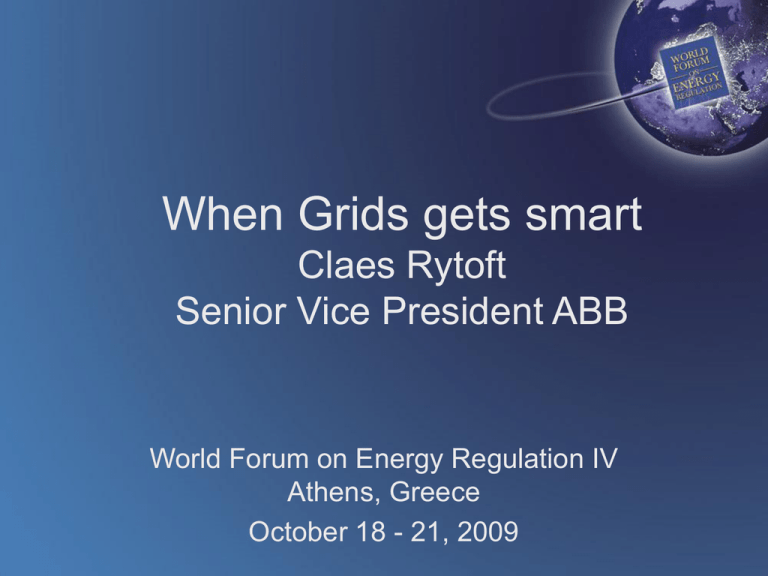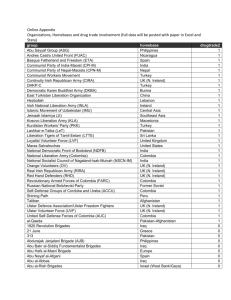2.C._Rytoft_s_presentation
advertisement

When Grids gets smart Claes Rytoft Senior Vice President ABB World Forum on Energy Regulation IV Athens, Greece October 18 - 21, 2009 Electricity consumption set to double by 2030 E le c tric ity G e n e ra tio n 4 0 '0 0 0 40,000 • Avg. global annual growth rate 2.5 % • Highest growth rate in Asia :4.5 % • China to consume more than US before 2015 Terawatt hours (TWh) 3 5 '0 0 0 in T W h 3 030,000 '0 0 0 2 5 '0 0 0 2 020,000 '0 0 0 1 5 '0 0 0 1 010,000 '0 0 0 5 '0 0 0 0 1990 1990 2004 2004 2015 2015 2030 2030 Electricity consumption growth/yr 2006-30 in % Electricity consumption in kWh per capita 18'000 Japan 15'000 OECD Europe 12'000 North America 9'000 Brazil 6'000 Middle East World avg: 3,240 3'000 China 1% 2% 3% 4% 5% US A Ja pa n Ru ss Ge i a r So man y ut h Af ric a Bu l ga ria M al a ys ia Ch i na Br az il Ira q Al ge ri a In di a 0% Ca na da 0 India Source: IEA, Claes Rytoft - World Forum on Energy Regulation IV - Athens, Greece - October 18-21, 2009 Annual emission of CO2 in Gigatons Climate change concerns need to be addressed 550* policy scenario 45 450* policy scenario 40 9% 14% 35 23% Nuclear CCS Renewables Energy efficiency 30 54% 25 20 2005 * ppm concentration in the atmosphere 2010 Reference scenario 2015 2020 550 policy scenario 2025 2030 Source IEA 2008 450 policy scenario Energy efficiency and renewable power can provide almost 80 percent of the targeted reduction Claes Rytoft - World Forum on Energy Regulation IV - Athens, Greece - October 18-21, 2009 Fundamental changes in power supply are coming More renewable power generation Energy efficiency Distributed and intermittent generation Customer pricing expected to foster demand responses Impact on grid stability and efficiency Grids of the future will be different from those of the past Open for all types and sizes of generation technologies Integrating demand side in system operation Claes Rytoft - World Forum on Energy Regulation IV - Athens, Greece - October 18-21, 2009 traditional grids Evolution of grid design From traditional to future grids • • • • • future grids • • • • • • Centralized power generation One-directional power flow Generation follows load Operation based on historical experience Limited grid accessibility for new producers Centralized and distributed power generation Intermittent renewable power generation Consumers become also producers Multi-directional power flow Load adapted to production Operation based more on real-time data Claes Rytoft - World Forum on Energy Regulation IV - Athens, Greece - October 18-21, 2009 Impact of Smart Grids example of challenges Generators: – Optimize ‘spinning reserves’ with increased amount of renewables Transmission utilities: – Maintain grid stability with increased amount of renewables – Reduce transmission losses Distribution utilities: – Maintain protection system integrity with increased amount of renewables – Demand Response and real time price information – Reduce distribution losses Consumers: – Optimize electricity consumption – home automation (incl. local generation PV, vehicle,….) Claes Rytoft - World Forum on Energy Regulation IV - Athens, Greece - October 18-21, 2009 Impact of Smart Grids – example of challenges Source : Statnett Claes Rytoft - World Forum on Energy Regulation IV - Athens, Greece - October 18-21, 2009 Balancing the need for more power with lower climate impact Connecting grids Renewables integration Demand response Plug-in vehicles Power flow control More power Key enabler: ICT - Information & Control Technologies Claes Rytoft - World Forum on Energy Regulation IV - Athens, Greece - October 18-21, 2009 Demand response DSO NCC (control room) Consumer Bi-directional communication Home Energy Management System Electrical connection • Consumer interaction and services • Improved load management • Enhanced reliability Claes Rytoft - World Forum on Energy Regulation IV - Athens, Greece - October 18-21, 2009 Example SmartGrid projects from ABB BorWin 1 Off shore wind park HVDC Grid Connection, Germany -Lowers CO2 emissions by ~1.5 mill. t/yr by replacing fossil-fuel generation 2000 km HVDC line to connect hydro power, China -93% efficiency -Savings vs AC line enough to supply power to more than 1 million consumers in China PV Solar plant in Spain - Produces 2.2 GWh/yr, displaces 2,200t greenhouse gas emissions p.a. Claes Rytoft - World Forum on Energy Regulation IV - Athens, Greece - October 18-21, 2009 Future scenario: Solar power from Sahara Surface of Sahara 9 million km2 Area needed to produce all European electricity 18 000 km2 Area needed for all world energy 650 000 km2 Connecting large scale solar-based generation eg, deserts, with distant load centers via an efficient transmission system like HVDC Claes Rytoft - World Forum on Energy Regulation IV - Athens, Greece - October 18-21, 2009 Do smart grids matter? Source: DoE and NETL Claes Rytoft - World Forum on Energy Regulation IV - Athens, Greece - October 18-21, 2009


